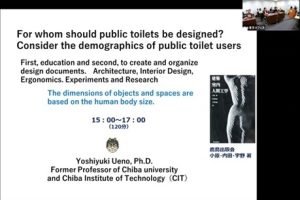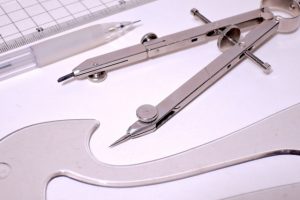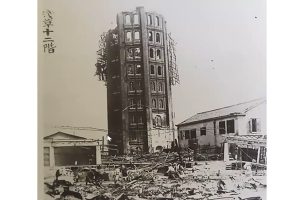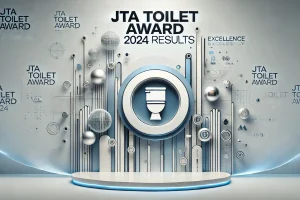On 19 November 2020, Japan Toilet Association (JTA) Chairman Dr. J. Kobayashi gave a lecture by Zoom at the Universal Design Center (IHCD) in Boston with the consecutive interpreters: Dr. N. Hosono and M. Hosono (Fig.1). Coincidentally 19th November was “World Toilet Day” assigned by United Nations. It was from 9:30 AM in the morning in Boston, but from 11:30 PM here in Tokyo. It was held at the invitation of Ms. Valerie Fletcher, the executive director of Institute for Human Centered Design (IHCD) in Boston.
https://www.humancentereddesign.org/news-events
Until last year, these lectures were held in a group in the Boston office, but from this year it became a form of lecture by Zoom due to COVID-19, and on the contrary, it became easier for audiences from each country to join. This time about 100 people from all over the world participated. The two hours of the lecture consisted of two parts. In the first half part, Dr. Kobayashi introduced about 100 slides of her achievements. Since there are many Japanese audiences, Ms. Valerie requested to add Dr. Kobayashi’s remarks in Japanese as well as English. First Dr. Kobayashi spoke in Japanese, and then the interpreters spoke in English in the form of sequential interpretation (Fig.2).
It is to upload them on YouTube now.
https://youtu.be/pFTCQArij5U
The contents of the lecture are divided into four items as follows;
1. Basic concept for the toilet design
2. Four case studies (rail station and motor way service area toilets, commercial facility toilets, public toilets, and school toilets)
3. Six points to be especially important items when toilet designing
4. Three examples of her favorite works
The second half part was a question-and-answer session from the audience, and the main questions were as follows;
・ With the pandemic, do you have new ideas/concepts for the design of the public toilet going forward?
・ How did you convince clients to understand that it is in their best interest to devote more space to toilet rooms? It seems to be a major problem in the United States to convince clients of the importance of restrooms
・ How do you navigate issues of private/public ownership in relation of toilet management, maintenance, cleaning etc.
・ It seems that the 1980s was the turning point, but what was the cause?
・ How did you overcome the taboo of the toilet topic in Japan? France is still taboo.
・ Can you please tell us more about acoustical privacy in public toilets?
・ What is the bed for people with disabilities noted in some of the designs? Also, what are the fitting boards noted alongside changing stations and baby chairs?
・ Japan is renowned for its washlet/bidets. Why are they not available in public facilities?
・ What is the preference for sit vs squat posture in public vs private toilet facilities?
・ Can you compare toilet dwell times in Japan vs elsewhere?
Finally, Ms. Valerie gave the following words of thanks;
I am so grateful for your willingness to do this. There is so much ignorance about the state-of-the-art in Japan and no one understands that this has been a choice to do elevate toilet room design to art. I know many of the audience were especially fascinated by the role of women in this story!

Fig.1 iHCD Web Information of November 2020

Fig.2 A Snapshot Screen of the Staffs
Upper left: Dr. Kobayashi, upper center: interpreter Dr. N. Hosono, upper right: Ms. V. Fletcher, Bottom left: Operator PJ, Bottom right: Interpreter Ms. M. Hosono
【日本語訳】
ボストンから小林会長がトイレについて講演
2020年11月19日に小林会長が,ボストンにあるユニバーサル・デザイン・センター(iHCD)から,Zoomによる講演会でスピーチを行い,逐次通訳は,細野直恒,昌子が行いました.(Fig.1) 奇しくも当日11月19日は,「世界トイレの日」でした.ボストンは朝の9時半からですが,時差があるので,日本時間では真夜中の11時半からでした.アメリカの大学では良く開催されるランチセッションと言って,昼食を摂りながら聞くというスタイルの講演です.今回はiHCDのバレリーセンター長からの依頼で開催されました.
https://www.humancentereddesign.org/news-events
昨年までは,この講演会は皆がボストンのオフィスへ集合して開催されましたが,今年からコロナ禍によりZoomによる講演会の形式になり,反って各国からの参加も容易になり,今回は世界から約100人が参加しました.講演の2時間は2部形式で構成されており,前半は小林さんがご自身の業績のスライド約100枚で紹介しました.日本の聴衆も多いので,英語だけではなく小林さんの日本語の発言も加えたいというバレリーさんの要望でしたので,まず小林さんが話されて,その後に通訳者が話すという逐次通訳の形式で実施されました.(Fig.2)
収録画像はYouTubeにアップされました.
https://youtu.be/pFTCQArij5U
講演の内容は,次のように大きく4項目に分かれています.
1. トイレ設計に対する基本概念
2. 実施4例(駅やSAのトイレ,商業施設のトイレ,公共トイレ,学校のトイレ)
3. 設計時に特に大切にしている事の6点
4. 好きな作品集3例
第2部の後半は聴衆からの質疑の時間でしたが,主な質問としては,
・ コロナ禍に伴い、今後の公衆トイレのデザインについて、新しいアイデアや対策はありますか?
・ トイレにもっと多くのスペースを割く事は,彼らの最善の利益に繋がる事をクライアントにどのように理解して貰うように説得しますか? トイレの重要性をクライアントに納得させることは、米国ではなかなか難しい様です。
・ トイレの管理、メンテナンス、掃除など、私的・公的での場所管理の問題をどのように乗り越えていきますか?
・ 1980年代が変換点だったそうですが,何が原因だったのでしょうか?
・ 日本では,トイレの話題のタブーをどう克服しましたか?
・ 公衆トイレの音響プライバシーについて,詳しく教えてください。
・ いくつかのデザインに記載されている障害者のためのベッドとは何ですか?
また交換ステーションやベビーチェアの横にあるフィッティングボードとは何ですか?
・ 日本はウォシュレット/ビデで有名です。 なぜ公共施設で利用できないのですか?
・ 日本はウォシュレット/ビデで有名です。 なぜ公共施設で利用できないのですか?
・ 公共トイレ施設と自宅のトイレ施設では,ベンチ型と日本型の設置傾向は如何ですか?
・ 日本と他の国のトイレの滞留時間の比較がありますか?
最後にバレリーさんからは,次のお礼の言葉を頂きました
「私は,小林さん達が,今回の試みを喜んで実施してくれた事に感謝しています。 日本の最先端技術については多くの人は知らないで、これがトイレのデザインのアート性を高めるための寄与している事を理解している人は少ないです。 聴衆の多くが小林さんの講演に因って,女性の役割について感動した事を私は気がつきました.」

Fig.1 iHCD Web Information of November 2020

Fig.2 A Snapshot Screen of the Staffs
左上:小林さん,中央上:通訳者 細野直恒,右上:バレリーさん
左下:オペレーター PJ,右下:通訳者 細野昌子










